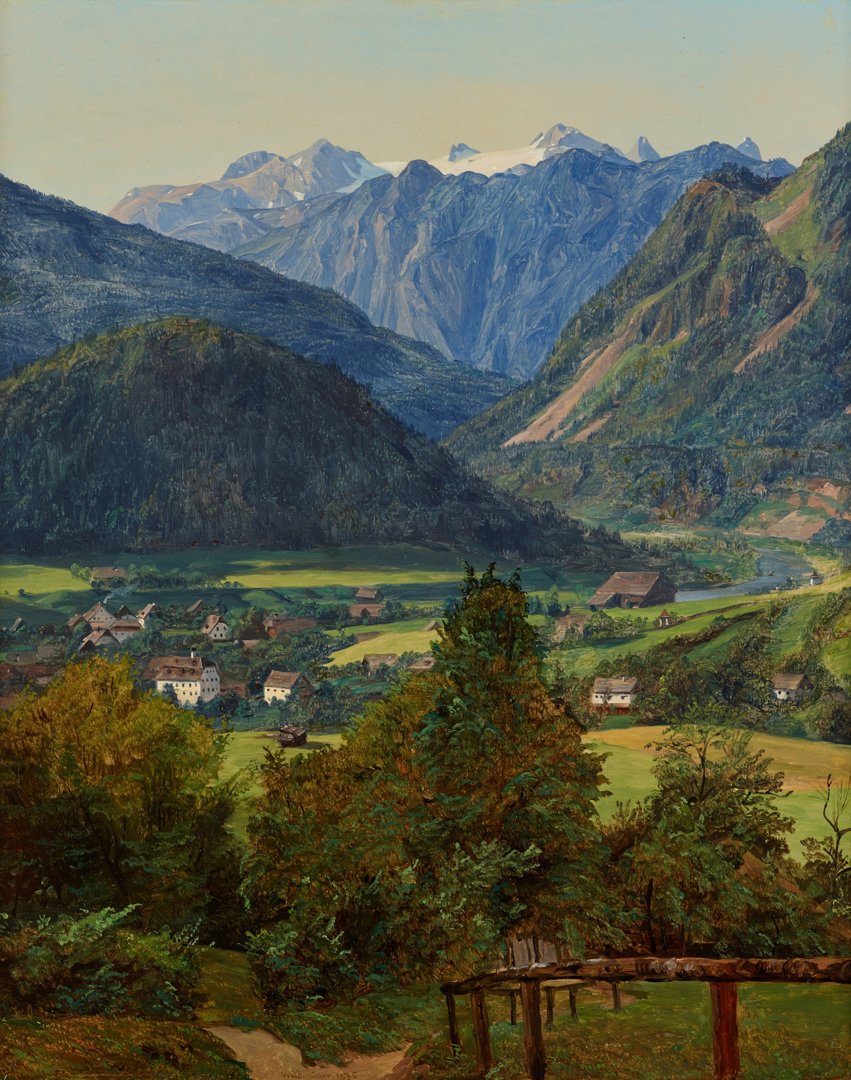The National Gallery stages first UK exhibition of Austrian painter Ferdinand Georg Waldmüller
Waldmüller: Landscapes
2 July – 20 September 2026
The National Gallery
Room 1 (The H J Hyams Room), Admission free
In summer 2026 the National Gallery will present the first ever UK exhibition of paintings by the Austrian 19th-century artist Ferdinand Georg Waldmüller (1793–1865).
Waldmüller: Landscapes (2 July – 20 September 2026), additionally the first devoted solely to his work as a landscapist, is a collaboration between the National Gallery and the Belvedere Museum, Vienna, which is lending most of the works on display.
Waldmüller is one of the most important figures in Austrian 19th-century art, significant for his work both as an artist and as an influential teacher. As well as landscapes, he painted portraits, genre pictures and still lifes (notably flowers and fruit), all characterised by his absolute commitment to truth.
He was one of the leading artists of Austria’s Biedermeier period, which roughly spanned the Congress of Vienna in 1815 (which aimed to reshape Europe’s borders following the Napoleonic Wars) to 1848, the year of revolutions throughout Europe, including revolts against the Habsburg monarchy and the political leaders within Austria itself. The period was characterised by both a burgeoning urban middle class, whose taste and financial power shaped developments in music, theatre and art, and an increasing popularity in paintings focusing on private domestic life.
Co-curator Sarah Herring says: ‘While Waldmüller is considered a Biedermeier artist his work, along with other artists of the period, can be both moralising and unflinchingly honest.’
Having enrolled at the Academy in Vienna in 1807, Waldmüller received a traditionally academic education in art – such as drawing after the Antique. He taught himself landscape painting by copying Dutch 17th-century landscapes, particularly those by Jacob van Ruisdael and Meindert Hobbema, and this was a genre which became increasingly important to him from the 1820s onwards.
Waldmüller’s attention to detail, photographic clarity and equal treatment of elements in the landscape is comparable to the work of the British Pre-Raphaelite artists. Waldmüller visited London in 1856 bringing with him 34 works which were all sold at auction following a private audience with Queen Victoria and Prince Albert, each of whom bought one of his paintings. While Waldmüller would have seen paintings by the Pre-Raphaelites at the Royal Academy, his technique and approach had developed independently, informed by his overriding desire to capture the truth of nature.
Beginning with landscapes of the Prater, the exhibition will show the artist’s early development in this genre. Here, in Vienna’s famous park, he made a series of studies of trees in line with a move towards naturalism throughout Europe.
Sarah Herring, Co-curator of Waldmüller: Landscapes, says: ’Many of the Prater pictures focused on dead and dying branches. Such an emphasis on unidealised nature derived in part from Dutch 17th-century landscapes, which had been copied by Waldmüller. In the 19th century, the move away from the ideal and the illustrious was an element in Realism, reflected also in the adoption of ordinary men and women as subjects.’
The exhibition will continue with his paintings of the Salzkammergut, an Alpine region near Salzburg, encompassing trees, views of the lakes and mountains, all rendered with a photographic clarity, limpid light, and almost-always bright blue skies and intense colour.
'Waldmüller: Landscapes' will also focus on the artist’s views of Sicily, painted during visits each autumn from 1844 to 1846. His landscapes demonstrate the profound impact of the island’s light, landscape and Classical ruins on his work.
And the final section of the exhibition will look at Waldmüller’s later works painted after his trips to Italy – where the effect that the extraordinary Italian light had on him continues to be felt. The exhibition will finish with 'Early Spring in the Vienna Woods' (1861, Belvedere, Vienna). Depicting a group of children gathering violets in the Vienna woods, it demonstrates his move away from pure landscape or scenes with small figures to one where he incorporated large-scale figures or groups.
The exhibition will comprise about 14 works, mostly from the collection of the Belvedere, with other loans from the Liechtenstein Collection and the Vienna Museum.
'Waldmüller: Landscapes' is curated by Sarah Herring, Associate Curator of Post 1800 Paintings at the National Gallery and Dr Arnika Groenewald-Schmidt, Curator of the 19th-Century Collection, at the Belvedere, Vienna.
Exhibition organised by the National Gallery, London in cooperation with the Belvedere, Vienna.
The H J Hyams Exhibition Programme
Supported by The Capricorn Foundation
Notes to editors
Picture credit
Ferdinand Georg Waldmüller
'View of the Dachstein from the Sophien-Doppelblick near Ischl', 1835
Oil on wood
Belvedere, Vienna
Publicity images can be obtained from https://press.nationalgallery.org.uk/
'Waldmüller: Landscapes'
2 July – 20 September 2026
The National Gallery
Room One, Admission free
Press view: Tuesday 30 June 2026
Tour
'Ferdinand Georg Waldmüller: True to Nature'
27 February 2026 – 14 June 2026
Belvedere, Vienna
The exhibition in the Belvedere will show how landscape painting experienced a heyday across Europe during the 19th century. Ferdinand Georg Waldmüller was part of this development, capturing people’s yearning for the natural world in his intimate portraits of trees, sweeping landscapes from the Vienna Woods, and iconic views of the Salzkammergut. This exhibition sheds light on Waldmüller’s landscapes in the context of his time. Trailblazing contemporaries, such as John Constable and Jean-Baptiste Camille Corot, inspire us to explore Waldmüller’s depictions of nature against the backdrop of wider European developments. Curated by Arnika Groenewald-Schmidt. Assistant Curator: Kati Renner.
The National Gallery
The National Gallery is one of the greatest art galleries in the world. Founded by Parliament in 1824, the Gallery houses the nation’s collection of paintings in the Western European tradition from the late 13th to the early 20th century. The collection includes works by Artemisia Gentileschi, Bellini, Cezanne, Degas, Leonardo, Monet, Raphael, Rembrandt, Renoir, Rubens, Titian, Turner, Van Dyck, Van Gogh and Velázquez. The Gallery’s key objectives are to care for and enhance the collection and provide the best possible access to visitors. Admission free. nationalgallery.org.uk
For more information and images
National Gallery Press Office on 020 7747 2865 or email press.external@nationalgallery.org.uk

